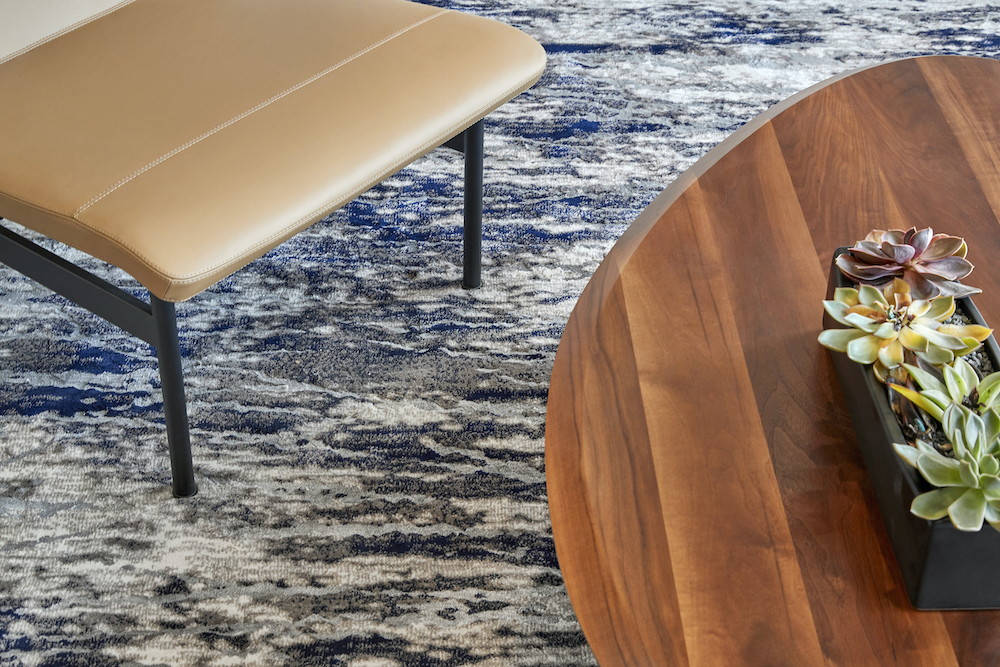Jeff Knoll of Ted Moudis Associates explores the importance of prioritizing resimercial design to adjust to rising expectations as we return to work.

The term “Resimercial” design—the practice of introducing residential design into the commercial workplace, is a trend we are seeing emerge at hyperspeed following the return to work amid the COVID-19 global pandemic.
Over the last two years, we’ve grown accustomed to the comforts of home. As we continue the increasing shift to in-person work environments, adaptation is a must to help support the transition back to the office. Employees expect comfort over a stark, cold atmosphere, they crave diversity and choice in where and how they work. At home, they are able to sit at a desk for heads down, intensive work; relax on a sofa and take a Zoom conferencing call; eat and work at the dining room table; or take a walk outside to decompress. The same work/life balance flexibility should also be in the workplace with benching, Zoom rooms, huddle rooms, working cafes, and relaxation rooms. The shift in workplace design is accommodating these needs.
The logic behind resimercial design is that comfortable employees are happier and significantly more productive and creative.
The logic behind resimercial design is that comfortable employees are happier and significantly more productive and creative. The main goal of this emerging trend in workplace design is to create both a welcoming and comfortable place to spend time, integrating resimercial design elements into our workplaces. The introduction of comfortable seating, a variety of lighting options, flexible spaces, and accessories into the workplace helps us find the right balance between comfort and productivity. This could be as simple as taking the time to consider the seat height of a banquette at a working café to promote dining and laptop use or considering the firmness of a sofa to ensure comfort for prolonged use.

Bringing the Natural Comforts of Home to the Office
Resimercial spaces should be designed to maximize and take advantage of the windows and views available within most offices. Biophilic design, replicating the sensations of the natural world, also contributes significantly to our productivity. The incorporation of plants and green walls, natural materials and even the patterns of light and shadow recall light streaming through trees are a few examples. Comfort not only means a comfortable chair and wood walls, but also means privacy. When we work at home, we have the privacy to host a confidential conversation with a colleague, a quiet space to focus, and the ability to take a personal call. Workplaces need to offer these same comforts by providing huddle rooms with soft furnishings to meet with a colleague, quiet rooms with ‘library etiquette’ to focus and phone rooms for private personal conversations.
Comfort not only means a comfortable chair and wood walls, but also means privacy.
Lighting is another key factor to consider. Often it is the level and quality of the lighting in our homes that set a tone, an ambiance, and provide us with comfort. In the workplace, our productivity is directly linked to lighting. This could mean providing open work areas flooded with natural daylight or creating the sensation of natural daylight in spaces without access through lighting options. Daylight harvesting, the temperature of light fixtures, the ability to dim lights, and having the ability to control one’s lighting to suit your needs are all examples. Diversity of lighting design throughout a space (bright, dim, direct, indirect, cove, task, etc.) are all as equally important as the diversity of workspaces.

Understanding The True Meaning of ‘Resimercial’ Design
When selecting materials, textures and colors for a resimercial space, there are no universal solutions. Our varying personal experiences and references all impact our associations with materials. A particular shade of green may remind one client of a cozy lodge while it may remind another of their grandmother’s stuffy home or another of that ‘70s apartment they once hated. For some clients, deep saturated colors feel comfortable. And for others, neutral, monochromatic tones provide the warmth they seek. Regardless of the differences, how a fabric feels and how a piece of furniture ‘sits’ is important to all and more and more clients want to touch and test these in person.

The biggest consideration when merging these styles is that the office still has to function primarily as a workplace. Any residential aspects of design that are incorporated into the office must be flexible enough to be comfortable, but also satisfy ergonomic needs for long-term use and integration of technology. No one wants to sit on a soft sofa that is too deep for hours and not have the ability to plug in their laptop or connect to the screen to meet with their team members. Naturally, the other consideration is durability and cleanliness. Everyone wants the warmth, softness and comfort of residential finishes and furnishings, but employees don’t have to worry about their co-workers occupying the same furnishings. Additionally, clients want a space that is welcoming and inviting, but the comment ‘that looks like my living room’ is typically considered a negative one in reaction to design options.
Resimercial design goes beyond just physical attributes. Creating an authentic space is the true core of residential-inspired design for the workplace. We need to create experiences that help the workforce readjust to the office and promote mental well-being. As we learn to navigate a sense of a ‘new normal’, concerns about the transition back to an office setting are valid, and resimercial design could be the answer to many of those questions.

